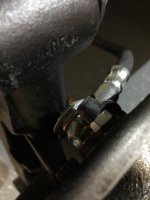turbo500
Member
- Joined
- Mar 20, 2013
- Messages
- 251
- Points
- 118
I thought it would be better for me to start a dedicated thread for my 500 since I'll have a lot of questions to ask you guys, and I want to avoid opening hundreds of threads 
So let's get to it, my 500, its an F, from 1966. It's been a long process of getting it over to the states, but finally it arrived. The journey itself was quick, thanks to a new route the cargo ship has recently started sailing. It took quite a beating on the cargo ship, seems like a lot of salt water/humidity and heat.


This was while it waited to board for its first transatlantic trip. Sitting next to some of it's modern day relatives (Alfa Romeo Stelvios) as well as some New Holland tractors.
Anyway, once it arrived to the port, it again took another serious beating, with daily thunderstorms for a week while it waited to be cleared from customs
Managed to get it trucked down the day after it cleared, and started work on it the moment I pulled it into the garage.
Now thanks to your recommendations I ordered some parts, they arrived today, and will work to change them out tomorrow, starting with the brakes.
So here are some questions I had before I go ahead a mess something up :
:
-What grease should I use for the hub nut area? Mobil1 M1 / Lucas Red #2 grease ok? They are both lithium complex, both with GC-LB rating, so they're indicated for wheel bearings.
-When changing out the brake pump, is it a simple swap out, do I need to do anything to prime it with brake fluid/ considering I'm going to be swapping out all the brake cylinders/brake pads/brake drums and handbrake levers inside the drums. Anyone have a guide showing how to do this?
-I also got copper exhaust gaskets, because I noticed the gasket connecting the exhaust pipe to the exhaust manifold is leaking. Can I simply swap them out for the copper ones, or do I need to do any sanding or apply gasket sealant before tightening the bolts?
I have to overthink these things because I can't just stop by my local car parts store and pick up what I need, so I would rather triple check!
Thanks again guys, and I wanted to thank Luxe and all the other users who helped answer my questions about importing it to the US.
Ciao
So let's get to it, my 500, its an F, from 1966. It's been a long process of getting it over to the states, but finally it arrived. The journey itself was quick, thanks to a new route the cargo ship has recently started sailing. It took quite a beating on the cargo ship, seems like a lot of salt water/humidity and heat.
This was while it waited to board for its first transatlantic trip. Sitting next to some of it's modern day relatives (Alfa Romeo Stelvios) as well as some New Holland tractors.
Anyway, once it arrived to the port, it again took another serious beating, with daily thunderstorms for a week while it waited to be cleared from customs
Managed to get it trucked down the day after it cleared, and started work on it the moment I pulled it into the garage.
Now thanks to your recommendations I ordered some parts, they arrived today, and will work to change them out tomorrow, starting with the brakes.
So here are some questions I had before I go ahead a mess something up
-What grease should I use for the hub nut area? Mobil1 M1 / Lucas Red #2 grease ok? They are both lithium complex, both with GC-LB rating, so they're indicated for wheel bearings.
-When changing out the brake pump, is it a simple swap out, do I need to do anything to prime it with brake fluid/ considering I'm going to be swapping out all the brake cylinders/brake pads/brake drums and handbrake levers inside the drums. Anyone have a guide showing how to do this?
-I also got copper exhaust gaskets, because I noticed the gasket connecting the exhaust pipe to the exhaust manifold is leaking. Can I simply swap them out for the copper ones, or do I need to do any sanding or apply gasket sealant before tightening the bolts?
I have to overthink these things because I can't just stop by my local car parts store and pick up what I need, so I would rather triple check!
Thanks again guys, and I wanted to thank Luxe and all the other users who helped answer my questions about importing it to the US.
Ciao



